Topic: CTF2 - let's have some in-depth analysis with images!
1. General stuff
1.1 About the whole thing and me
Let me start off by saying that I had so much fun doing this, it ended up getting quite long. If you're lazy, skip to part 2 immediately for the analysis. If you're really lazy, consider to continue trolling other threads. If you're really, really lazy, well, just stay in bed.
There's much talk in this one thread about ctf2 being the lone map played by the "pros" and muchos community drama. That's sad, because when I heard there was something going on in this regard, I hoped for an interesting discussion about mapping and the related gameplay, rather then a who-did-what-and-didn't-listen-to-whom, since I am very interested in the former, while only minimally involved in the Teeworlds community.
This also goes to making me ask you to please excuse mistakes in anything related to actual gameplay. While I did consider me a quite above average player for certain periods, I never got into the whole scene and stuff, so there may be mistakes. I don't want to show definitive truth, though, but encourage objective discussion. So don't flame me, just point out the mistakes and bring this further!
1.2 Why I write this
I don't want to convince anyone of anything in here. For me, the question isn't whether it's good or bad that "pro players only play ctf2". I, too, would like more diversity in maps, but this mustn't come at the price of playing bad maps. There has to be a way to make maps that are as good as CTF2, yet different, and I want to work out an approach to this by working out what it really is that makes CTF2 great.
1.3 Mapping standards
There is nothing wrong with maps following a certain pattern. I don't know whether anyone here is familiar with the mapping history of StarCraft1, but it's quite interesting. Basically, Blizzard managed to ship the game with a good chunk of maps (must've been over 30 I think), but only one of them proved to produce really interesting games. This one was called "Lost Temple" or LT for short. Of course you can always argue that the playstyle on other maps was just "different" and not "worse", but however you choose to call it, the fact is, after some time LT was basically the only one of Blizzard's original maps being played on battle.net (at least in "low ressource" 1v1 and 2v2). And since then, (nearly) each and every map being played by people who have some kind of an understanding of the game follows the same basic layout. StarCraft was released over ten years ago, and in South Korea, where some people are really "pro"gamers, meaning they play SC for a living, there are still new maps being introduced every few months. And, in a way, they are all like LT. Which does not mean the gameplay on all of them is the same. It just ensures the gameplay isn't total crap to begin with.
1.4 The holy grail of gameplay
Before we begin then, I'd like to suggest something called "speed" as the holy grail of (pro) gameplay. "Tension" might be very related, "flow" too. When trying to understand, why ctf2 is so appealing to people that aim to play TW on the highest level, one needs to understand that velocity is something valued by a broad range of "elitist" players across a variety of games. Maybe not the most popular ones - because who plays the most popular game rarely has to defend himself - but those gotten short oftentimes point their game out to be the faster one, the more interesting one, the one taking more skill. StarCraft-players did so in regards to Wc3, Quake-players in regards to CS. And I sympathize with them. SC and Quake are the better games. Getting into that zone where you're so fucking fast is just great. It's like a drug.
2. Analysis
2.1 Different Levels of Analysis
I think we can discriminate between two different levels when looking at the design of ctf2 and maps in general. The first one I'd like to call "microstructures", the second one is logically the "macrostrocture".
Microstructures are like little "ideas" that, together, make up the map - and of course intertwine. (Look below for examples.) I think these are interesting to look at in the ctf gametype, because this is where duels take place. You usually don't go out of your way to kill someone. Unless your target is the flag carrier, you won't follow him over the whole map. At any given time, your main target is to capture the flag. Not to get frags. But if two players run into one another at the 3hp/gl/3ap spot on ctf2, for example, they will frequently exchange grenades until one of them dies. This is making up a good chunk of the constant action.
Now macrostructure is of course what you get if you look at the whole thing. Basically it's places like base and mid, but we'll have a closer look later.
2.2 Microstructures
Having admitted fast and challenging gameplay as the key features we desire, let's look at the microstructures of ctf2. It's quite fascinating how clearly these features are integrated in them.
Since the microstructures actually holding some pickups are the most interesting ones, let's look specifically at those. If we think about it for a moment, we can seperate them into two groups.
First, we have those which offer pickups at a slight deviation from the path you would normally take, if you wished to get into the enemie's base as quickly as possible.
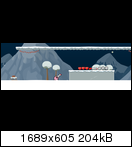
figure 1: 3hp/gl/3ap, classic stand-off
The decicive point is that to retain your speed as well as get the stuff, you need _skill_. I think everyone knows this microstructure inside out. Jumping too early, you have to use the hook mid-air and lose speed, or even land in front of the block and get stuck; jumping too late, you miss some of the pickups and choose whether to go back or not. If you do it perfectly, it feels good.
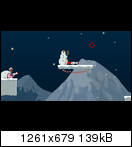
figure 2: mid gl's to fight over and take smoothly
Another thing to consider when looking at this kind of microstructures is that you don't leave the same way you got in, meaning there is an entrance and an exit. Else you'd have to change direction by 180°, so you'd lose (all) speed, which isn't how we defined this kind of microstructures.
Since there is an entrance and an exit, there is - like I mentioned above - the possibilities, that two player meet, coming from different directions. If sides are balanced, you get a quick burst of action.
What if sides aren't balanced?
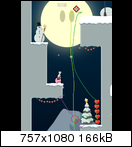
figure 3: outer base entrance as flag carrier supplies
As this is the entrance into the base, it's actually quite nice to have it imbalanced, I'd like to argue. It provides the flag-carrier with the opportunity of getting himself some room to breathe, if he's trying to getting into his base that way while being followed. Not for free, though. There's an initial moment of losing distance, where your persuers might come into hooking range. There's also the possiblity of getting +5 health - again, for the price of a small deviation from the path. It all depends on skill.
Apart from that, we have to see, whether it is a good thing to have a base with unbalanced structures like this, when considering the macrostructure.
2.3 A second kind of microstructure
First, there's the second kind of microstructure I'd like to talk about, though. It refers to those which are kind of a blind alley. Generally, you won't lose much speed, if you're good at them, but they are naturally a larger deviation from your 'standard path' most of the time, and they result in a different kind of fight.

figure 4: mid laser, not the weakest position
Since there's only one way in, there is usually no fighting over the powerup in itself. First to get to the microstructure has good chances to get the power-up, too. If he was followed, though, he is now trapped. So there's always a choice to be made, whether one wants to get himself into such a situation. In the above picture, there's still much room to use, when on the platform of the laser, so it's rather a commitment: "I'm gonna take the laser and try to control mid with it", since mid is widest open. Who's not fighting mid doesn't have to bother much with the laser.

figure 5: 5ap/gl base "last resort"
This is entirely different and very interesting, I think. It's both a constant renewal of supplies for the flag carrier, if his team has good control of their base, and kind of a last resort. For a flag carrier to die in there is not unusual and while you sometimes rejoyce about having someone trapped in there, some players are exceptionally good at fighting from inside there and end up surviving.
Again, this is a trade-off: Bad position against ressources. If your team has it secured - yay, armour! If not, it's a very vulnerable spot to get in, which often sees someone getting out with less total hp/armour than he got in. Which leads to it being an interesting spot, where you have to rely on your speed and on your skills.
2.4 Macrostructure
There are certainly players with more insight about this than me. I only want to suggest that the areas serve different causes. Mid is the area which is the widest. Still, a relatively tight control can be established on the enemy here - especially when he's pushed back to his entrance into mid. Here, the microstructures definitely favour the respectively attacking side. Hence, mid becomes valuable ground to control.
Then there is the transitional area. Since the players are falling down into it from above, it's a good place to gain speed. Also, the shotgun and gl/3hp/3ap pack are great to start and rarely are you not catching one of these / sg or gl in your base.
Now the base itself is quite easily defendable. I think this only makes sense. Moving the most defendable place to somewhere else will obviously lead to a lower ratio of caps/snaps. Having no place that's nicely defendable will lead to short-lived flag carriers and even less caps/snaps. I think the ctf2 model is at the very least a solid model as far as this is concerned.
2.5 Combine it!
Let's have a look at how the different kinds of microstructs are spread out over ctf2:
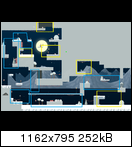
figure 8: microstructure allocation
Maybe not surprisingly, we see that the one-entrance-structures (yellow) are present mainly in base and mid, while mid also has a two-way-structure (blue), allowing to get a grenade launcher without losing speed and going straight through mid into enemy territory.
There's two boxes where I couldn't settle for one color. The bottom shotgun is more smooth to get if your spawn was to the left of it. It's on a very weak position overall, making the area below the base harder to defend. We'll soon come to look at this closer.

figure 9: ideal and deviation paths
Here one can see the fastest and the deviating paths again. It's only from the perspective of one starting point, but I hope you get the idea. Green is fast, easy and safe, red is slighty slower and above all harder to do, because you need to go along very specific tiles, meaning if you screw up, you miss the pick-up, have to go back, or lose speed.
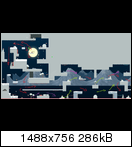
figure 10: positional strength
Here I want to consider positional strength and weakness. It's kind of a continuation of what I already said about macrostructure. This time, look at the arrows like each of them pertaining to a certain microstructure. Green is a weak position, red a strong one and purple kinda depends. Starting from the base, there are many red arrows. If you focus on it, securing this area can be done quite effictively.
Moving into mid, there's two green arrows, indicating if you have been pushed out of mid, it's hard to get into it again. Like I said, this makes controlling mid a desirable thing. The fight over mid is quite interesting, though. Absolute mid is kind of a weak position. GL platforms are strong against the upper part of transitional, but tees from the lower part may slip by. Laser platform can be strong against GL platform, but it's not a given.
So mid is fragile. Base and the space below it are not, but if you chose to only hold onto them, you won't win, because your enemy is gaining a huge lead in ressources.
2.6 Conclusion
To conclude this chapter, let's recapitulate our core findings. CTF2 has interestingly placed pickups, in that they either require skill to get flawlessly (but then it's really possible to barely lose any time) or put you in an interesting position. Fights over pickups are generally taking place in spots that differ from one another. On the larger scale, CTF2 has a dynamic mid and more static bases. All in all, we get a relatively fast paced and also skillful gameplay.
3. This is how you could do a comparison
Now that we have stuff worked out, we can have a look at ctf6, for example, taking into account our new-found aspects of analysis.
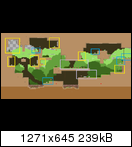
figure 11: microstructure allocation in ctf6
This is a picture of ctf6 with microstructures pointed out. I actually had to introduce a new border color here. It's grey/purple and stands for: "basically for free". Especially the health is really hard to miss. Maybe you miss one heart, but who cares? Also, consider what happens when you meet someone there. There's so much space that there's hardlythere's just so much wrong here in comparison to ctf2. We have two grenades into yellow borders that are actually not part of the base anymore. Who is supposed to get these? Newly spawned players on their way to mid? A chore. Flag carriers on the run for their base? Suicide.
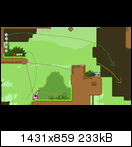
figure 12: 5ap/gl as flag carrier supplies?
No sane person would ever go for the gl and armour there, when on the run. The time you need to collect the pickups gives your enemies time to cut your route off. Compare figure 3 and figure 5. Both work in more interesting ways, as in both cases you have an interesting chance to survive by playing good and getting the hearts / being saved by spawning team mates.
As for the blue structs, they aren't really blue. I just colored them blue, because you don't go in the same direction you get out, usually. But you can very easily see that all of them are placed on some kind of a ledge. And most of the time, you come from below. So you get no damn speed. Even though they're supposed to be two-way microstructures, they feel incredibly slow, because you can't move through them in a good way. The shotgun on the bottom is actually the only one of them which is placed alright, because you can just manage it to jump at the right moment to get the shotgun and do not get stuck. This is also because you come from above here. The other weapons, it's just hook upwards, take weapon, hook upwards again. No elegance.
And so on. I don't want to get into this too much. Do some analysis on your own : )
4. Well then, make a good map instead of writing damn walls of text, if you're so clever!
I'll be working on this!

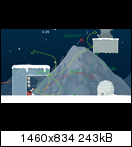
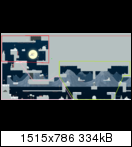





 I'm interested in seeing how Chi11y views your analysis...
I'm interested in seeing how Chi11y views your analysis...